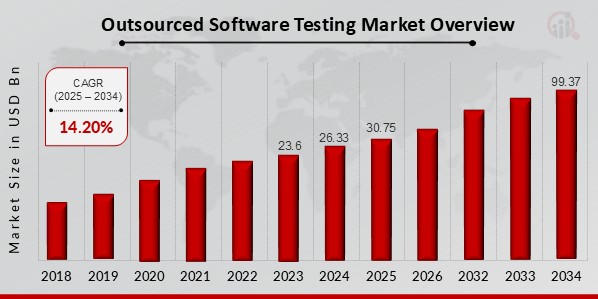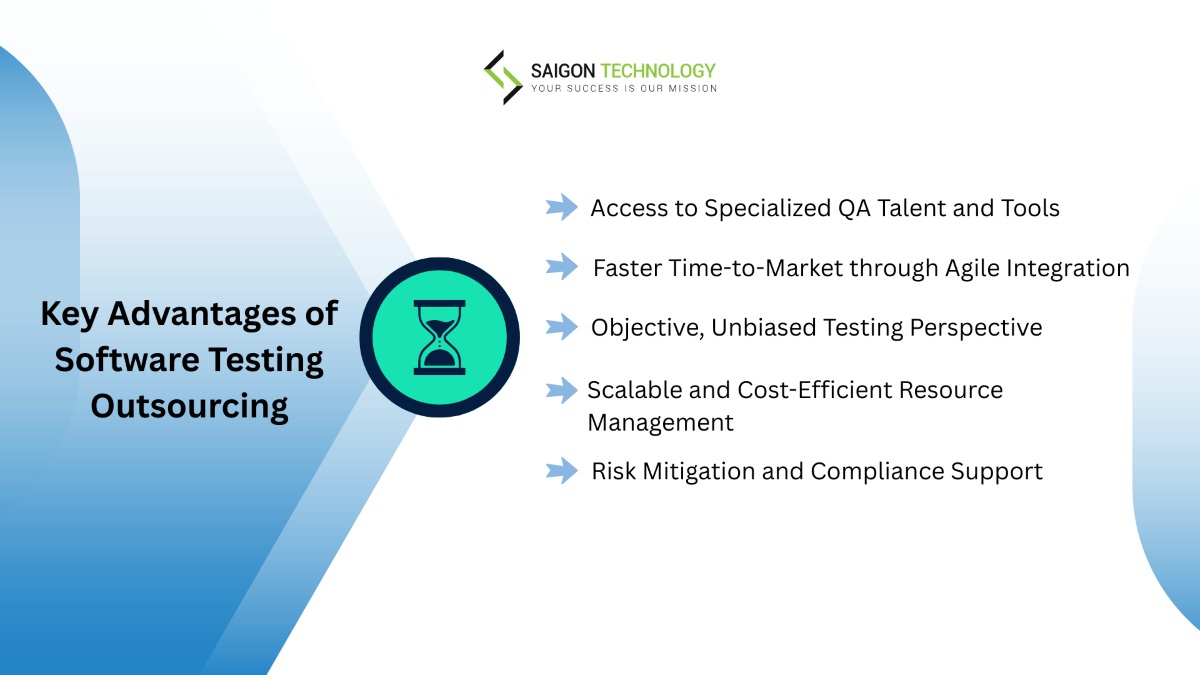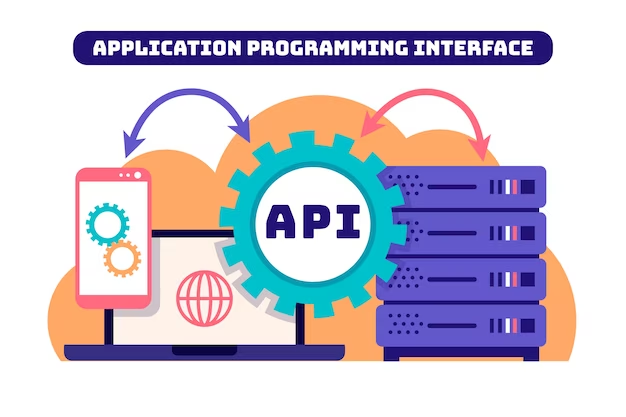Software testing outsourcing has developed rapidly. Its global market is expected to rise from USD 30.75 billion in 2025 to USD 99.37 billion in 2034. There are many reasons for this impressive growth. Businesses need high-quality testing tools to ensure their products are top-notch. Yet, it’s not easy to build an agile and scalable team for the tests. That’s where outsourced QA services come into play.
Source: Market Research Future
With this approach, you can gain access to industry experts and ensure cost efficiency. The external experts also bring a fresh perspective to your project. Your experienced partner helps accelerate time-to-market, too. This article will help CTOs, product managers, QA leads, and startups explore the ins and outs of software testing outsourcing. Let’s read on to discover!
Key Advantages of Software Testing Outsourcing
Many businesses consider outsourcing software testing a cost-saving solution. Yet, it’s not the only benefit you can get. Let’s break down the actual advantages of outsource software testing.
1. Access to Specialized QA Talent and Tools
By outsourcing software development, you get access to industry experts. Software testing outsourcing companies will give you certified QA engineers, performance testing pros, and test automation specialists. They know tools like Postman, JMeter, TestRail, and Selenium inside out. Since the experts already have frameworks and test scripts, you don’t have to build a QA team from scratch.
Plus, you tap into a global talent pool with sector-specific knowledge. For example, a mid-sized SaaS company teamed up with a QA vendor. Together, they implemented regression testing. This approach cut manual work by 60% and boosted release quality.
2. Faster Time-to-Market through Agile Integration
QA is now part of the development process, not something done after. Top outsourcing teams use Agile and DevOps to test early. Thanks to CI/CD, bugs don’t slow things down, which means faster launches.
One e-commerce startup can even cut its release time in half. They improved time-to-market by outsourcing regression and device testing.
3. Objective, Unbiased Testing Perspective
External QA teams offer a fresh perspective. They are not too close to the product like in-house teams might be. It means they spot the issues your internal staff miss. Unbiased validation ensures an excellent outcome.
4. Scalable and Cost-Efficient Resource Management
With software testing outsourcing, you can scale your QA team as needed. There is no need to hire full-time staff for short projects. So just bring in help when you want it. That’s real scalability.
Outsourcing also boosts cost efficiency. A fintech company built a whole QA team within a week. This team had manual, automation, and security testers. No delays anymore!
5. Risk Mitigation and Compliance Support
Security is super important in fields like finance and healthcare. Reliable QA vendors follow global standards like ISTQB, ISO 27001, and ISO/IEC 29119. The experts focus on clear reports, broad test coverage, and intense security testing.
Overview of Software Testing Outsourcing Types and Models
You can outsource software testing in different ways. There are several types and models to consider.
Types of Software Testing Outsourcing
We classify outsourcing software testing based on the location of the QA provider. So, there are three types: onshore, nearshore, and offshore. This comparison table will make it clear:
| Onshore Outsourcing | Nearshore Outsourcing | Offshore Outsourcing | |
| Location | In the same country as your business | In a nearby country | In a distant country |
| Communication Style | Easy face-to-face interactions | Smooth with shared working hours | Requires effective communication tools |
| Time Zone Differences | None | Minimal | Significant |
| Cultural Alignment | Strong | Good | Varying |
| Cost | High | Moderate | The most cost-effective solution |
| Expertise Availability | Limited | Good | High |
| Pros | – Easy collaboration
– Similar cultures – Strong data security |
– Lower costs than onshore
– Convenient collaboration |
– Cost-effectiveness
– Access to more talent |
| Cons | – High labor costs
– Limited scalability |
Fewer provider options | Time zone and cultural differences |
| Best For | Fields and projects that need real-time collaboration and compliance with many regulations | Companies that require real-time communication at lower costs | Long-term testing, automation, and regression-heavy projects |
Learn more: 10 Types of Outsourcing: Which One Is Right for You?
Models of Software Testing Outsourcing
Outsourced software testing services come in different models. Each serves different budget and timeline requirements.
1. Dedicated QA Team
In this model, you have a full-time team dedicated to your project. These external specialists learn your product, processes, and business culture to ensure continuous testing. This model is ideal for companies that need agile and long-term QA teams.
2. Project-Based Outsourcing
You engage a QA provider for a specific phase, such as user acceptance testing (UAT) or minimum viable product (MVP). Once the scope is done, the engagement ends. So, it works best for startups and seasonal product launches.
3. Staff Augmentation
This software testing outsourcing model brings external testers into your in-house team. This way, you can scale up quickly for a release or address a skills gap. Thus, it’s suitable for enterprises that need experts immediately without a long-term commitment.
Step-by-Step Software Testing Outsourcing Process
Outsourcing software testing requires a structured process so that everything can run smoothly. Let’s explore the steps!
1. Requirements Analysis
Every good test plan starts with requirements analysis. The QA team reviews business requirement documents (BRDs) and user stories. They also check acceptance criteria.
Tip: If you consider software testing outsourcing, don’t wait! Share requirements early so everyone can be on the same page, even if they are in a different time zone.
2. Test Planning
In the test planning phase, the QA lead maps out your testing strategy. This plan covers everything, including goals, timelines, and whether to go with manual testing or automated testing. Common tools used here are Google Docs and Confluence. The QA team then keeps everything in a test plan document.
Tip: In this stage, be sure your partner understands your reporting cadence, tools, and SLAs.
3. Test Case Design
During test case creation, testers write clear steps for what to test. They include all positive, negative, and edges. Boundary cases and data preparation are part of the tests. The testers use tools like Xray, TestRail, and Zephyr to handle the test suites for better organization.
Tip: Ask your partner for a requirements traceability matrix. It will help link every test back to a requirement.
4. Environment Setup
During this test environment setup stage, the QA team prepares test environments. It can be on the cloud or on-premise, whatever your project needs. This job involves testing data and relevant configuration. Don’t forget to agree on who owns the environment provisioning: you or your outsourcing partner.
5. Test Execution
Now, it’s time for test execution based on the approved cases. The QA team reports issues in real-time as they work on testing. Some common test types to perform are functional, regression, smoke, and performance testing. Tools like Selenium, Appium, and Postman assist in this stage.
Tip: You can stay involved in the tests with your vendor through shared tools like Slack and Jira.
6. Defect Reporting and Tracking
Testers log every bug with steps, severity, and screenshots. Developers jump right in to fix all the issues. Jira and Bugzilla are vital tools for defect reporting and tracking. Some key metrics to monitor here are test pass rate and defect leakage rate. Bug fix turnaround time plays an equally important role.
7. Test Closure
We are at the final stage: test closure. The QA team wraps up testing and creates a summary report. The report includes metrics, lessons learned, and a sign-off checklist. When you outsource software testing, make sure to share all deliverables clearly.
Software Testing Outsourcing: Myths and Truths Uncovered
Want to outsource software testing but worry about the risks? You are not alone! While software testing services offer many benefits in terms of time and cost savings, you may still be hesitant because of the myths out there. Let us help you clear up the concerns!
Myth 1: “Manual Testing is Obsolete — Automation Does It All”
Not true! Automated testing is excellent for tasks like regression and speed checks. But manual testing still matters, especially when you need human judgment. Think about UI/UX testing here. So, combine both approaches. With software testing outsourcing, your QA partner can bring the right balance of skills and testing tools to make it work.
Myth 2: “Outsourced QA Teams Deliver Lower Quality”
External testers comply with global standards like ISTQB and ISO/IEC 29119. They know which testing technologies work best for your business. You also have clear SLAs and detailed test documentation to keep you involved in the project. Continuous feedback loops ensure continuous security audits. That’s how you get outstanding outcomes. So, quality is all about how your partner handles your project, not where they are.
Myth 3: “Outsourcing = Losing Control”
Outsourcing means you share data with an external company. But don’t worry! Before the project starts, you sign a Non-Disclosure Agreement (NDA). Your vendor uses Slack, TestRail, and Jira to give you full visibility into test cases. The QA manager ensures defect tracking and real-time updates, too. Plus, your vendor offers test artifact templates to maintain communication between the vendor and your in-house QA team. Regular sprint reviews guarantee transparency. It means you can control the QA process.
Concern: “Will the QA Team Guarantee Bug-Free Software?”
No team can promise that. Even the best miss a few bugs sometimes. But with outsourcing software testing, you get teams focused on results. The external experts aim for high test coverage, fewer leaks, and quicker releases. Some also include vulnerability assessments to catch security issues early. These metrics are achievable and business-focused.
Top Challenges in Software Testing Outsourcing
Software testing outsourcing offers many advantages. Yet, you still face challenges without good planning. Let’s see what they are and how to overcome them!
1. Communication Barriers and Time Zone Differences
Communication bottlenecks and time zone differences can slow things down. When you and your vendor work at different hours and don’t share the same language, delays happen.
To fix this issue, you need to set clear processes. Async tools like Slack and Loom are also helpful. Remember to agree on SOPs for updates, bugs, and test reports. Another solution is to learn about cultural differences. Once you know the working culture, you can close communication gaps.
2. Inconsistent Testing Quality
Sometimes, you get unsatisfactory quality. This issue comes from immature processes. The testers end up with vague test cases, poor reporting, and missed defects. Transparency issues may arise.
So, you need to choose a partner who follows international quality control standards like ISTQB and ISO/IEC 29119. Before starting, you should ask for sample test plans. Check the test coverage metrics and QA workflows as well. It would be best to set Service Level Agreements (SLAs) for resolution time, regression test cycles, and bug tracking.
3. Security and Intellectual Property (IP) Risks
Working with external QA teams? Your codebases and test environments may face data security concerns or even data leakage.
In this case, you should sign an NDA first. Also, ensure your vendor complies with data privacy and protection laws like ISO 27001 and GDPR. Another solution is to limit access. You can use staging data and set role-based permissions to stay secure.
4. Lack of Domain Understanding
External testers are good at their job, but they may lack domain expertise. This issue leads to ineffective test scenarios.
The best solution is to give your partner the full picture of your domain, including BRDs, user personas, and product walkthroughs. Plus, involve the outsourced software testing team early in the development cycle. Sprint planning sessions and user story reviews can really help. Lastly, consider early onboarding to help them better understand your domain.
5. Integration Issues with DevOps and CI/CD
CI/CD pipelines can break due to testing delays and compatibility issues. It becomes more common when outsourcing software testing without DevOps alignment.
In this case, your QA team should use tools like Azure DevOps, Jenkins, and GitHub Actions. Make sure their tests fit right into your pipeline. You can also automate smoke and regression suites to speed things up.
How to Find the Right Software Testing Outsourcing Partner?
Ready for outsourcing software testing? You first need a reliable partner. Here are some steps to take:
1. Define Your Testing Requirements
Before talking to vendors, you should know exactly what you need. Are you looking for performance testing or manual support? Do your projects demand HIPAA compliance or meet data protection regulations? Requirement specifications must be precise from the start. That way, you can choose a QA team that fits your business context. They can then easily follow your industry standards.
2. Build and Refine a Vendor Shortlist
Next, use review sites like LinkedIn, GoodFirms, or Clutch to find some reputable names in the software testing outsourcing industry. You should look out for:
- Proven track record
- Honest case studies
- Positive reviews
It would be best to skip anyone with vague services or no tech blog. Then, shortlist 3-5 vendors based on team size, testing infrastructure, and engagement models. You can consider virtual interviews to learn more about how they work.
3. Assess Compatibility and Communication
Beyond technical skills, you need to see if your vendor can communicate smoothly with your in-house team. Something to do for this step is:
- Check if they share working hours with you
- Review their English proficiency index
- Ask them to offer sync calls and standups
- Consider communication tools like TestRail, Slack, and Jira
- Ask how they manage test documentation
4. Run a Pilot Project
Try a small project first. A 2-4 week pilot is a great start. Right here, you need to choose a real feature or test case. Define clear metrics, too, like turnaround time, detection rate, and test case quality. Thanks to the pilot, you can minimize risks and build confidence. In this phase, you can evaluate your partner’s:
- Test coverage
- Domain expertise
- Collaboration efficiency
- Testing tools and technologies (data encryption, disaster recovery, network firewalls, single sign-on, test environment, and test strategy)
5. Finalize with a Clear Agreement
Happy with the pilot? Now, it’s time to sign the outsourcing contract. It should include the following:
- SLAs for test coverage and defect response time
- Scalability, which is about how your partner scales the team up and down without penalty
- Intellectual Property Protection
- Confidentiality agreements
Best Practices for Outsourcing Success
As you outsource QA testing, you need a strategic plan to take full advantage of your partner and avoid risks. Here are some key practices to ensure a successful project:
1. Choose the Right QA Partner
Start by selecting a vendor with proven success in your field. Check for certifications such as ISO 27001 or ISTQB. You should also review their case studies and read client reviews to see how they match your business. A pilot project can help you test their communication, testing technology, and delivery quality. After the pilot, you can determine whether to commit or not.
2. Define Clear Communication Channels
Strong communication channels are key to smooth outsourced testing. You should pick tools like Jira and Slack for updates and feedback. Remember to plan daily check-ins and regular test reports, too. And if managed well, time zones become an advantage. You can ensure 24/7 workflows to speed up the testing process.
3. Set Measurable QA KPIs
Set clear Key Performance Indicators (KPIs) from the beginning. They help everyone stay on track. You can also improve your testing process over time. Some metrics to include are:
- Defect Detection Efficiency (DDE)
- Test Case Execution Rate
- Defect Leakage Ratio
- Automation Coverage
4. Protect Data and Intellectual Property
Security must be the top concern in your quality assurance strategy. An NDA can guarantee your data stays secure. Plus, make sure they follow GDPR or SOC 2 rules. Ask how they protect the test environment and control access, too, to avoid data leaks.
5. Adopt a Hybrid Testing Approach
Great software testing outsourcing involves using the right testing methodologies. While manual testing helps you catch UX issues, automation speeds up repeat tests. Tools like Katalon and Cypress make things smoother and more consistent.
6. Start with a Trial Phase
Try a short-term project first. This phase allows you to test your partner’s skill, process maturity, and domain understanding. A basic smoke test can quickly reveal their testing ability. Moreover, as you work with your partner for a short time, you can see if they align with your internal workflows. All these strategies help reduce long-term risks.
7. Continuously Monitor and Improve
Outsourced QA needs regular check-ins. You need to give constructive feedback loops and review work using bug-reporting tools. Besides, stick to agile methodologies and maintain clean test documentation. QA maturity models are helpful, too. You can use them to assess process evolution over time. That’s how you drive continuous improvement.
Power Your Business With Exceptional Software Testing Outsourcing
The future of software testing outsourcing is bright. This approach helps you reduce costs, boost quality, and accelerate delivery. Enhancing software quality with outsourcing is a smart move if done right. The question is: How to do it properly? You should try vendor directories for choosing reliable QA providers first. The ones with cost-effective QA solutions and domain expertise will be the best. Think about how outsourcing software testing can support your goals, too. Here is a brief checklist for evaluating outsourcing readiness:
- Defining clear goals and scope
- Collecting necessary documentation, including test cases, process documentation, and requirements
- Engaging key stakeholders
- Validating traceability
- Evaluating test coverage
- Assessing disaster recovery planning
- Addressing compliance gaps
- Promoting collaboration and automation
So, are you ready to outsource? Find strategic QA partnerships first. Contact Saigon Technology now and grow together!











